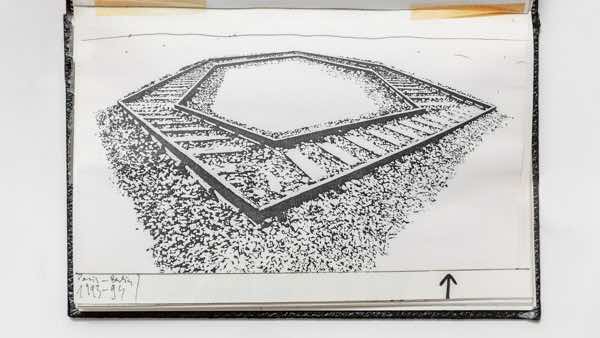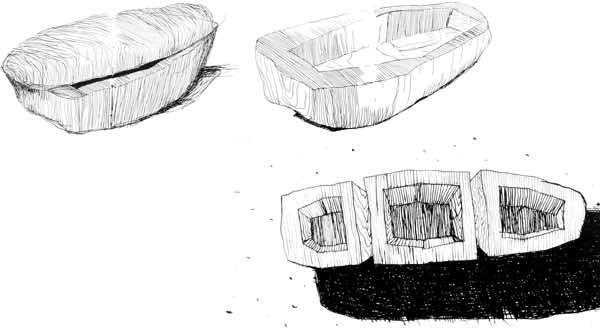State of memory is the general title given by Tomasz Struk to several installations conceived, constructed and exhibited in many places over a period of about ten years.
State of memory is composed of wooden railways sleepers laid on a floor covered with wood chips. Placed on the railway sleepers are one, or most often several, six-sided wood sculptures of different sizes, with more or less elongated forms. Different variations of the installation depend on the environment: sometimes the sculpture is surrounded by mirrors, sometimes by compositions of painted works or graphics, sometimes by other objects arranged in immediate proximity.
The creation of the installation required a long patient work of carpentry: hundred of elements precut in the studio are brought together to fabricate meters of rails.
Tomasz Struk performs here a symbolic inscription of the Holocaust into the traditional form of Polish coffin portrait; But the hexagon remains empty: the depiction tears loose out of the frames, unable to fit in any form.
The suggestive form of remembrance is supposed to provide help in grasping an inconceivable event: the empty hexagon is made from rails, a symbol of the tragic journey to death chambers.
The rails, as if removed from their sleepers, form a shape with a double meaning. Not only do they represent the symbolic disassembly of the sinister track and its transformation into a form of remembrance, but also they turn the road leading into the abyss, now consisting only of sleepers, into a road that is crossed out at every step – a negation of the purpose of the road itself.
Leszek Brogowski

As the title suggests, memory is central to the work. In place of the rails of a railway, an equivalence is made with a path "of wood" and a hexagonal form in the place where the railway cars usually run, all in an image frozen in time: this representation of the tragic railway "of iron" of the times of the deportations then operates in the hollow of our memory ; memory obsessed, saturated, lacunary, impersonal, empty, all at once - and holds fast there, remaining in a contemplative plea.
The word "state" implies as much a permanence as a moment of representation. The installation creates a pause in the common historical memory ( the transportation of the deportees to the camps ) and creates an object of art which, existing in the present, has the symbolic power to break away from an old narrative threatened by oblivion.
The role of art in preserving individual and collective memory is the question which was of the greatest importance in the reflection of Tomasz Struk in a very rich context:
– The geographical context: 1992 was the year the artist moved to Berlin, a city which is eminently the place of a memory, which is constantly illustrated and reworked through historical research and memorial initiatives (Topographie der Terror in the middle of the city, next to the Martin-Gropius-Bau Museum, and later, an initiative to build, in the new German capital, a site consecrated to the Jews of Europe who were murdered ).
– The cultural context: in the 80's, Polish artists ( Bałka, Libera, Żmijewski, to cite the most well-known) gained fame through a certain representation of the Holocaust, long after the generation who was its witnesses or its victims. Tomasz Struk belongs to this epoch which invented a new language to create images which expressed the thoughts of generations born after the war.
–The family context: Through Europe in the 90's, "the Righteous", (those who, because they had saved Jewish lives during the Holocaust, got from the israeli state a medal) were asked to tell their stories, to preserve them for future generations. In this context, the artist's aunt was invited to testify in front of the Spielberg foundation's camera. Facing the imminent disappearance of this living testimony the artist, asked himself what his role as a creator should be in preserving and renewing the memory of these deeds, which decided the fate of a number of Jewish and polish families. In the face of the risk that these events might be forgotten, the work State of memory is a medium for transmission by symbolic means of a language which is both personal and collective.
State of memory is an uninterrupted interrogation process.
Tomasz Struk
State of memory invites us to ask questions:
Can the work offer a symbolic reparation to the traumatizing memory of the rails transporting the Jewish deportees of Europe toward their horrible destiny, one of the saddest memories of the 20th century?
Can we see here a redeeming revitalization through the gesture of the installation and the use of wood as a material: indeed, it is tree which are planted at Yad Vashem to make the memory of the rescue of existences that otherwise were condemned, live on and grow, in the image of the growth of trees. In this way, can we struggle against he trivialization or worse, the casual exploitation of the memory of the Holocaust?
The railway sleepers of wood, and the hexagonal objects, equally of wood, which are placed on them, seem to operate a transmutation (this vision can be seen in the notebooks of the artist): from the lifeboat or from the ark of salvation, Tomasz Struk, in his first sketches and creations, borrows the elongated form which becomes that of a hexagon, which, in Polish culture, is consecrated to funeral portraits. If the the deportation convoys are translated into the language of an artistic representation, the one created by Tomasz is conspicuous in its silence – it does not babble, it does not provoke – and its meditative force. As for the thousands of pieces glued to each other to make up the installation, they make up us think in a literal manner of the "work" of memory, that consecration of the present, in terms of time and work, to that which is threatened with disappearance.
The boat, just as the funerary hexagon, has a funeral symbolism of Charon’s barge ferrying the souls of the dead across the Styx and the Acheron.
Bożena Kowalska

The wood carving is very close, because of this material, of the Ark composing certain versions of State of memory and it bears the same name. It is born in the form of drawings in the notebooks from 1999 onwards. It was conceived as an installation with a variant of devices that have never been implemented in reality. The genesis shows first hexagonal surface objects, lying or vertical, like stone raised from the Neolithic era.
According to a photo, taken in nature, of a stone cut in two, Tomasz Struk draws an open sarcophagus that shows a hexagonal bottom. It is divided into three hexagons in certain drawings of the 2000–2001 notebook. In other drawings, the sarcophagus serves as a cabin for plant elements (shrubs, grasses, grasses) and constitutes, as a State of memory, a memorial installation.